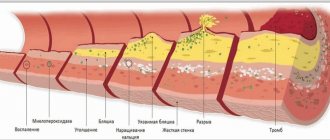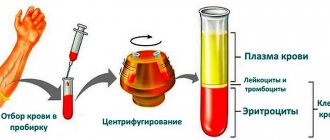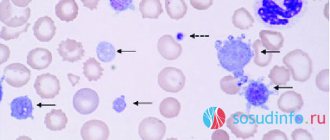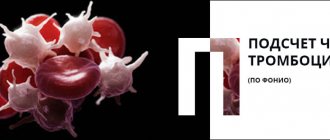The average platelet volume is increased, what does this mean? What are these blood elements? The task of platelets is to become active when blood vessels are damaged. This phenomenon can be explained from a physiological point of view, when a person has been in high altitude conditions or worked long and hard. But pathologies also become causes of increased levels of this substance. Then the person has a risk of thrombosis and heart attack, since platelets are responsible for clotting. Their excess does not bode well.
Flat bodies look like plates under a microscope. If a blood vessel is damaged, they immediately rush to repair it. Together with the endothelium (flat cells), these plates stop bleeding, forming a blood clot. In large vessels this process takes place somewhat differently. Our body has a complex system (hemostasis). It maintains the blood in a liquid state, but if the integrity of the vessels is damaged, it quickly stops it (macrocirculatory mechanism).
What factors influence deviations from the norm?
Platelet levels may decrease or increase. Their rate varies from 200 to 400*109/l. This indicator depends on the person’s health status. It is influenced by the time of year and weather. For example, in the spring, platelet levels drop. They also decrease slightly at night in all people, and during menstruation in women they reach 100 - 200*109/l. But this picture is physiologically determined and does not require drug intervention.
The average platelet volume is also lower in pregnant women, which is considered normal. But it is worth paying close attention to the health of the woman in labor if the level of flat cells is below 140*109/l. Bleeding is possible during childbirth.
The following conditions affect platelet volume:
- Liver diseases.
- Disturbances in the process of hematopoiesis in the bone marrow.
The average volume of flat cells is determined by doing a blood test. Using special equipment, doctors have learned to determine not only the level of these elements, but also the size of each platelet. They perform the function of maintaining optimal viscosity of the main body fluid. An equally important task is to monitor the integrity of blood vessels.
If the indicators are elevated, this indicates deviations in health no less serious than otherwise. But the processes when the average volume is high and the general level is higher are different states. An overestimation of the coefficient indicates the presence of thrombocytosis, which determines the quantitative indicators of flat cells. Average data speaks about their type. This level is used to judge the fullness of the values responsible for coagulation. Doctors say that mature cells of flat bodies are small and immature - they fill the blood more and more strongly. These are qualitative values that precisely determine the average flat cells. If this characteristic is increased, it means there are more immature elements, which indicates their inferiority.
The results regarding the number of platelets shown in the blood test are designated by laboratory technicians using several Latin letters. So the abbreviation for the average platelet volume is mpv and normally has a value of 7 to 11 femtoliters (Fl, Fl).
Treatment
If the test shows that your platelet level is below normal, you should undergo testing to find out the reason and decide how to increase your level. Treatment depends on the cause of this condition and is aimed primarily at eliminating it.
If the low platelet count is due to medications, they are discontinued. If severe bleeding occurs, platelet and plasma transfusions are performed. With significant blood loss and the development of severe anemia, transfusions of red blood cells and plasma may be required. To increase platelet production and suppress autoimmune reactions, immunoglobulin and corticosteroids are prescribed.
If there is no desired result with conservative treatment of thrombocytopenic purpura, heavy repeated bleeding, hemorrhages in important organs, splenectomy may be indicated - an operation to remove the spleen, the effectiveness of which is high (about 80%).
For thrombocytopenia, in order to strengthen the walls of blood vessels and increase blood clotting, a course of medications based on natural ingredients can be prescribed. These include products such as Derinat, Sodecor, and Etamzilat.
If your platelet count is low, doctors recommend eating right. It is necessary to avoid alcoholic drinks, hot and spicy foods. The menu should include more foods rich in vitamins A, C and promote better blood clotting. These are liver, fish oil, chokeberry, bell pepper, celery, green apples, parsley, rose hips, carrots, peanuts, pine nuts, almonds, grape and lingonberry leaves, birch sap.
In addition to proper nutrition, doctors recommend adhering to a healthy lifestyle, maintaining a daily routine, getting enough sleep, and not overexerting yourself physically and psychologically.
Video about the functions of platelets and the reasons for the decrease in their number in the blood:
When are upward deviations considered normal and when are they not?
The process of determining platelet levels on a hematology analyzer is much more efficient and accurate than the old methods of counting flat cells on glass. MPV – the average volume of these elements is presented in the form of a histogram. Young cells are on the right, old cells are on the left. The size of each element allows us to judge platelet activity. Old cells are smaller and not as dynamic as young ones. Increased MPV values indicate:
- possible anemia resulting in bleeding;
- a hereditary disease in which flat cells with defects are synthesized (macrocytic thrombodystrophy of Bernard-Soulier);
- tendency to bleed.
These elements are reduced if:
- The patient is pregnant.
- The human body is iron deficient.
- Inflammatory processes are present.
- There is a tumor.
- A heart attack begins.
- Diagnosed with thyroid disease.
- There are kidney diseases.
- Blood clotting is impaired.
- Increased cholesterol.
Platelet tests also use another feature that determines the quality of blood platelets - their width. And it indicates their volume (pdw). If deviations are observed here, this indicates:
- Inflammation in tissues or organs.
- Anemia.
- Helminths that have settled in the intestines.
- The presence of malignant tumors.
If the average platelet values are borderline normal or slightly exceed these characteristics, the body does not necessarily have complex diseases. When a similar picture is observed in a child, most likely hematopoiesis is defective, due to which immature flat cells are released. In adults, the above condition is observed after:
- Complex operations.
- Injury
- Internal bleeding.
- Heavy periods in women.
- Taking medications to activate blood formation.
In these cases, flat cells from the bone marrow are released into the blood in high quantities to compensate for the loss of the main fluid. In the process, a large number of unripe flat cells are released.
But there are also pathologies that are characterized by a low or reduced platelet count. If tests reveal a large or small value of these bodies, it is necessary to undergo further diagnostics. You may have diseases such as:
- Thrombocytopenia, when important elements of the blood are destroyed too quickly.
- Enlargement of the spleen and a simultaneous increase in the number of cells in the bone marrow.
- Diabetes.
- Atherosclerosis.
- Deviations in the functioning of the thyroid gland.
- Leukemia.
- May-Hegglin disease.
Abnormalities in platelets are detected in alcoholics or smokers.
It is known that if the level of flat bodies is high, their average volume decreases. And vice versa. This pattern does not work when the patient is diagnosed with diseases:
- thrombocytosis;
- injuries;
- abnormalities in the functioning of the bone marrow.
When a patient receives test results in person, they can only be deciphered by specialists. Even if the patient is sure that the information he has gives him the opportunity to make a diagnosis on his own, it is better to consult with his doctor or consult a professional hematologist. It will analyze all indicators and characteristics and compare even those values that in most cases do not affect each other. If in doubt, it is advisable to re-test. And only after this the patient is given a final diagnosis and advised what therapy needs to be carried out.
Folk remedies for the treatment of low platelet count
If you want to get rid of thrombopenia, you can use folk remedies (if the decrease is not associated with illness). For therapy, various natural ingredients are used, products that stimulate the production of platelet plates.
Sesame oil
Sesame oil makes good progress in the treatment of thrombopenia. You need to choose virgin oil, consume 1 tablespoon 2-3 times a day for 2-3 weeks. It is advisable to consume the product 30 minutes before meals.
Sesame oil is recommended because of its rich composition. Contains microelements:
- omega-3;
- vitamin E;
- lignans.
Sesame oil
When consumed orally, in addition to increasing platelets, it is possible to improve digestion, increase immunity, strengthen the cardiovascular system, and reduce the level of bad cholesterol. The product has virtually no contraindications for use. Long-term use is possible.
Nettle for thrombocytopenia
If a person suffers from low platelet concentration, it is possible to correct the condition using nettle. Decoctions and infusions are prepared from it. You can use the following recipe:
- You will need to prepare 2 tablespoons of dry nettle.
- Pour 200 ml of boiling water over the nettles.
- Let the prepared infusion brew for several hours.
You need to drink liquid 30 minutes before meals every day. The duration of treatment is 3-4 weeks. It is permissible to consume nettle over a long period of time.
Among the beneficial properties are stimulation of the immune system and improvement of metabolism. In addition, nettle infusions and decoctions actually increase platelets. After a certain period of time, their amount in the blood becomes normal. Coagulability improves.
It is important to know! To achieve noticeable results, therapy should continue for at least 2 weeks. After treatment, preventive measures must be taken to prevent the recurrence of thrombocytopenia.
Chokeberry
Rowan has a fairly large number of useful properties. With the help of chokeberry, it is possible to treat uncomplicated thrombocytopenia. The fruit contains many vitamins, nicotinic acid, and flavonoids. To prepare a medicine based on rowan, you can use one of the following recipes.
- Decoction - add 20 grams of fruit to boiling water. After this, you need to cook the liquid for 5-10 minutes. The decoction is consumed daily in small portions of 50 ml. The number of doses per day is 3-4 times.
- Infusion - 1 teaspoon of fruit needs to be poured into 250 ml of boiling water. Then let the liquid brew in a thermos for 5 hours. You need to drink a glass of the infusion every day.
- Jam - you need to take 500 g of fruit, 400 grams of sugar, 20 g of citric acid. The fruits are passed through a meat grinder and covered with sugar. Everything is thoroughly mixed. Add citric acid and other ingredients to taste. Jam is consumed with tea or any other drink.
Appearance of this type of rowan
You can also consume up to 150 g of fresh fruit almost every day for a long time. Using mountain ash you can experiment in different ways. In their fresh natural form, the fruits bring the greatest help. In winter, decoctions are made from frozen fruits.
Red blood cells are no less important substances in the blood
In medicine there is the concept of average red blood cell volume. With its help, doctors determine the size of red cells. This indicator is very different from the usual red blood cell level, which is determined using a microscope. It gives a more complete and accurate picture of the condition of the blood and the body as a whole. But the results of such a characterization will become incorrect if the majority of red blood cells are of a changed shape.
The average red blood cell count reveals the type of anemia:
- Namicrocytic.
- Normocytic (after bleeding).
- Macrocytic (with a lack of B vitamins, especially B9 and B12).
- Microcytic (iron deficiency).
The average erythrocyte volume mcv gives a characteristic of the size of red blood cells. This indicator is expressed in femtoliters or µm3 (cubic micrometers). Such substances play a huge role in many processes. If the quantitative indicator of the volume of red blood cells changes, this indicates inflammatory processes, or allergies or a deficiency of necessary substances.
What does a decrease in MPV mean?
A decrease in MPV may mean an enlarged spleen (splenomegaly), the presence of liver cirrhosis, hypoproteinemia, kidney disease, and thyroid pathologies. The platelet index decreases in aplastic anemia, septic thrombocytopenia, congenital megakaryocytic hypoplasia, Wiskott-Aldrich syndrome, X-linked thrombocytopenia with platelet microcytosis, thrombocytopenia caused by immunological destruction of cells, as well as during chemotherapy and during pregnancy. A significant decrease in MPV in the blood of a pregnant woman indicates a threat of miscarriage.
What does another equally important characteristic of red blood cells indicate?
The average hemoglobin content in a red blood cell indicates its level in one of these cells. This value is revealed as follows. The concentrated hemoglobin is divided by the number of red cells in the same amount of blood. It is characterized by laboratory assistants as mchc. It is more accurate than the color indicator and correlates with cell volume. Another name for it is mch. Depending on the deviations of this type of norm, doctors define anemia:
- Normochromic (when the destruction of red blood cells occurs much faster than the formation of new elements).
- Hyperchromic (decreased number of red blood cells).
- Hypochromic (color index less than 0.8).
The concentration of hemoglobin in a red blood cell indicates the saturation of this substance in the cell. If its production is disrupted in the body, deviations from the norm indicate pathology.
The indicator, which is called msns, is derived as a result of a blood examination using a specialized hematological machine. It is defined as the average hemoglobin in red blood cells. It is analyzed using a special formula. It contains the characteristics of hemoglobin in the blood and the part of its total volume that is made up of red cells. It gives a clear understanding of what type of anemia the patient has.
The peculiarity is that MSHC does not detect the absolute value of hemoglobin in red blood cells and does not depend on their volume. It shows its level in the total mass of red cells and reflects saturation.
Normally, this value is if, as a result of the analysis, the indicator varies from 320 to 360 g/l (for an adult organism). In children – 280-380 g/l.
If the measurement is carried out in g/dl, then other numbers are considered the norm:
- From 32 to 36 – in adults.
- From 28 to 38 – in children.
You should not completely correlate your results with the above values, since in some laboratories slightly different characteristics are accepted as the norm. In any case, only a hematologist will help evaluate the results.
Prevention
To prevent the development of thrombocytopenia in a pregnant woman, it is important to follow certain rules:
- Eliminate all factors that can negatively affect the state of the immune system;
- Before planning a pregnancy, get all the necessary vaccinations against ARVI, rubella, chickenpox and other viral infections;
- Stop taking certain medications in early pregnancy;
- Change your diet.
To prevent thrombocytosis, the following preventive measures are taken:
- maintaining an active lifestyle;
- Excluding foods that increase blood viscosity from the menu;
- Drink more fluids and food to thin your blood.
Be sure to monitor your platelet count throughout your pregnancy. This is why it is so important not to neglect regular examinations by specialists and examinations.
Symptoms
Symptoms characteristic of low MPV:
• tachycardia.
• being overweight.
• bluish tint of the skin.
• an increase in the size of blood vessels, the outlines of which are clearly visible through the skin.
• multiple subcutaneous hemorrhages, most often located on the anterior surface of the limbs, abdomen, and chest.
• frequent nosebleeds.
• women have long and heavy menstruation.
• hemorrhages in the retina.
When MPV increases.
Externally, an increase in MPV is more difficult to determine. However, there are a number of signs indicating this pathology:
• tachycardia.
• being overweight.
• bluish tint of the skin.
• an increase in the size of blood vessels, the outlines of which are clearly visible through the skin.











